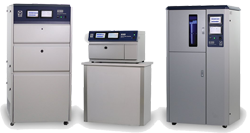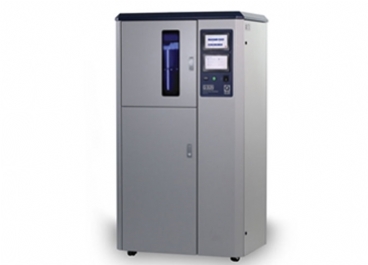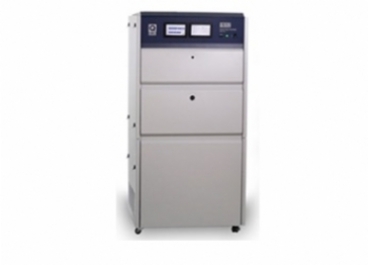耐候性試驗
Weathering Testing
咨詢熱線
18566398802ISO 105 B04
ISO 105 B04標準介紹
Foreword
ISO (the International Organization for Standardization) is a worldwidefederation of national standards bodies (ISO member bodies). The workof preparing International Standards is normally carried out through ISOtechnical committees. Each member body interested in a subject forwhich a technical committee has been established has the right to berepresented on that committee. International organizations, governmentaland non-governmental, in liaison with ISO, also take part in the work. ISOcollaborates closely with the International Electrotechnical Commission(IEC) on all matters of electrotechnical standardization.
Draft International Standards adopted by the technical committees arecirculated to the member bodies for voting. Publication as an InternationalStandard requires approval by at least 75 % of the member bodies castinga vote.
International Standard ISO 105-B04 wasprepared by Technical CommitteeISO/TC 38, Textiles, Subcommittee SC1, Tests for coloured textiles andcolorants.
This fourth edition cancels and replaces the third edition(ISO 105-B04:1988), of which it constitutes a technical revision.
ISO 105 was previously published in thirteen " parts ", each designated bya letter (e.g. "Part A"), with publication dates between 1978 and 1985.Each part contained a series of "sections", each designated by the respective part letter and by a two-digit serial number (e.g. "Section A01 ").These sections are now being republished as separate documents, themselves designated "parts" but retaining their earlier alphanumeric designations. A complete list of these parts is given in ISO 105-AO1.
Annexes A and B of this part of ISO 105 are for information only.
1 Scope
This part of ISO 105 specifies a method intended fordetermining the resistance of the colour of textiles ofall kinds, except loose fibres, to the action of weatheras determined by exposure to simulated weatheringconditions in a cabinet equipped with a xenon arclamp.
This method can be used to determine if a textile iswet light-sensitive.
NOTE1General information on colour fastness to lightis given in annex A.
2 Normative references
The following standards contain provisions which,through reference in this text, constitute provisionsof this part of ISO 105. At the time of publication, theeditions indicated were valid. All standards are subjectto revision, and parties to agreements based on thispart of ISO 105 are encouraged to investigate thepossibility of applying the most recent editions of thestandards indicated below. Members of IEC and ISOmaintain registers of currently valid InternationalStandards.
ISO 105-A01:1994, Textiles — Tests for colour fastness — Part A01: General Principles of testing.
ISO 105-A02:1993, Textiles — Tests for colour fastness — Part A02: Grey scale for assessing change incolour.
ISO 105-B01:1994, Textiles - Tests for colour fastness - Part B01: Colour fastness to light: Daylight.
ISO 105-B02:1994, Textiles - Tests for colour fastness - Part B02: Colour fastness to artificial light:Xenon arc fading lamp test.
3 Principle
Specimens of the textile are exposed under specifiedconditions to light from a xenon arc lamp and to waterspray. At the same time, eight dyed blue wool references are exposed to light but are protected fromwater spray by a sheet of window-glass. The fastnessis assessed by comparing the change in colour of thespecimen with that of the references.
If the method is used to determine if a textile is wetlight-sensitive (see 4.3.1), the simultaneous exposureof references is unnecessary. In this case the assessment is performed by comparison with the greyscale in accordance with ISO 105-A02.
4 Reference materials and apparatus
4.1 Blue wool references
The reference materials used in this test are those blue wool references specified in ISO 105-A01 and ISO 105-A02, and subclause 4.1.1 of ISO B01:1994.
4.2 Apparatus
4.2.1 Xenon arc lamp apparatus.
4.2.1.1Light source, in a welt-ventilated exposurechamber. The light source is a xenon arc lamp of correlated colour temperature 5500 K to 6500 K.
4.2.1.2 Light filter, placed between the light sourceand the specimens and references so that the ultraviolet spectrum is steadily reduced. The glass usedshall have a transmission of 0 % between 290 nm and300 nm, rising to at least 90 % between 380 nm and750 nm.
4.2.1.3Heat filters, placed between the light sourceand the specimens and references so that the amountof infrared radiation is steadily reduced.The spectrum of the xenon arc contains an appreciable amount of infrared radiation which should be minimized by the heat filters to satisfy the temperature conditions. The filters shall be cleaned regularlyto avoid undesirable reduction in light intensity by dirt.
4.2.2 Radiometer(when available/specified), formeasuring irradiance and radiant exposure.
Since irradiance at the test specimen face can varyas a function of lamp intensity and lamp-to-specimendistance, a monitoring radiometer may be used tocontrol uniformity of exposure. The radiometer permits exposure to an established level of irradiation(radiant energy flux per unit area) at a point in theplane of the specimen rack (see annex B).
4.2.3Opaque cardboard, or other thin opaque material, for example thin sheet aluminium or cardboardcovered with aluminum foil, or, in the case of pilefabrics, a cover that avoids surface compression.
4.2.4 Grey scale for assessing change in colour,in accordance with ISO 105-A02.
4.3 Exposure conditions
The test specimens and the blue wool references areexposed simultaneously in the apparatus (4.2.1), thespecimens to both light and water spray, and the references to light only. The air temperature in thechamber shall be measured with a thermometerwhose sensitive portion is shielded from the directradiation of the arc.
The temperature in the test chamber shall not exceed40℃ during the drying period.
The temperature of the black panel, which is measured in the centre and under the same illumination asthe specimens, shall not exceed that of the testchamber by more than 20℃ at the maximum dryingperiod (black panel temperature, see ISO 105-B02:1994, subclause 4.2.3).
The variation in light intensity over the area coveredby specimens and references shall not exceed+10 % of the mean.
4.3.1 Exposure of test specimens
The specimens shall be subjected to the followingaccurately adjusted, reproducible weathering cycle:
— duration of spraying: 1 min;
— duration of drying: 29 min.
For spraying the specimens, only completely ion-freewater shall be used. It should be especially noted thatthis water shall not contain any metal salts. Tubing,tanks and spray jets shall be of corrosion-resistantmaterial.
If the method is used to determine if a textile is wetlight-sensitive, the weathering cycle shall be repeatedfor a total of 16 h testing.
The specimens shall be mounted on a suitable holder.The specimens shall completely enclose the holderand the side to be assessed shall not be in contactwith metal plates, other specimens, or backing fabric.
NOTE 2 The holders described inTextil-Rundschau,18(1963) 2, 76, photo 2, left, may be used. The manufacturerof these holders also supplies a case to protect the references.
4.3.2 Exposure of colour fastness references
The blue wool references (4.1) shall be protected fromthe water spray by a shield of glass whilst being exposed to light from the same xenon arc lamp as thespecimens. The transmission of the glass shall be0% between 310 nm and 320 nm, rising to at least90% between 380 nm and 750 nm. The glass caseshall be well ventilated, i.e. there shall be an openingat the top and another at the bottom to allow goodcirculation of air.
5 Test specimens
5.1 If the textile to be tested is fabric, prepare twospecimens, each of a suitable size, mounted on holders or other equipment which will fit the weatheringtest equipment.
5.2 If the textile to be tested is yarn, knit or weaveit into fabric and treat it as described in 5.1.
Loose fibres are not suitable for weathering tests.
5.3 Mount strips of blue wool references on cardboard, (4.2.3), cover one-third of each as described inISO 105-B02:1994, 7.2.1.2 and fix the mounted references under glass according to 4.3.2.
5.4 Unexposed samples of original fabric identicalto those being tested are required as references forcomparison with the specimens during weathering.
6 Procedure
6.1 Procedure common to methods 1, 2and 3
6.1.1 Place the specimens mounted on the holders(see 4.3.1) in the apparatus and expose them continuously to weathering following method 1, 2 or 3(see 6.2 to 6.4).
6.1.2 At the same time, expose the mounted andpartially covered blue wool references (see 4.1 and5.3) to light in the glass case of the same apparatus(see 4.3.2).
6.1.3Only one side of the test specimen shall beexposed to weathering and light.
6.1.4 Whilst the specimens are drying, the air in thetest chamber shall not be moistened.
NOTE 3 The actual conditions of the weathering test depend on the kind of test apparatus used.
6.1.5 Contrary to stipulations for the outdoor exposure test, the specimens shall not be washed afterthe weathering test.
6.2 Method 1
6.2.1This method is considered most satisfactoryand is mandatory in cases of dispute over the numerical rating. The basic feature is the control of theexposure periods by inspection of the specimen and,therefore, one set of blue wool references is requiredfor each specimen under test. It is therefore impracticable when large numbers of specimens have to betested concurrently; in such cases, method 2 (see6.3) shall be used.
6.2.2 Expose the specimens and the blue wool references under the conditions described in 6.1 until thecontrast between the exposed specimens and a portion of the original fabric (5.4) is equal to grey scalegrade 3. Remove one of the specimens and cover asecond one-third of the references with an additionalopaque cover.
6.2.3 Continue the exposure until the contrast between the remaining specimen and a portion of theunexposed original fabric is equal to grey scalegrade 2. If blue wool reference 7 fades to a contrastequal to grey scale grade 4 before the contrast between the specimen and the portion of the originalfabric is equal to grey scale grade 2, the exposuremay be concluded at this stage and the remainingspecimen and the reference removed.
6.2.4 Prepare both specimens, and a portion of theoriginal fabric for assessment (see 6.4 and 6.5).
6.2.5If textiles are to be examined for wet light-sensitivity, a 16 h testing period shall be used prior toassessment.
6.2.6Assess the colour fastness to weathering inaccordance with the method given in 7.1 to 7.3.
6.3 Method 2
6.3.1 This method should be used when the numberof specimens to be tested simultaneously is so largethat method 1 is impracticable. The basic feature ofthis method is the control of the exposure period byinspection of the blue wool references, which allowsa number of specimens differing in weathering fastness to be tested against only one set of references,thus conserving supplies of the latter.
6.3.2 Expose the specimens and the blue wool references under the conditions described in 6.1 until thecontrast between the exposed and unexposedportions of reference 6 is equal to grey scalegrade 4. Atthis stage, remove one specimen fromeach pair and cover a second one-third of the bluewool references with an additional opaque cover.
6.3.3 Continue the exposure until the contrast between the fully exposed and unexposed portions ofreference 7 is equal to grey scale grade 4. Removethe remaining specimens and the references.
6.3.4 Prepare the exposed specimens and a portion
of the original fabric (5.4) from each specimen for assessment (see 6.5 and 6.6).
6.3.5 Assess the colour fastness to weathering ofeach specimen in accordance with the method givenin 7.1 to 7.3.
6.4 Method 3
Where the test is to be used to check conformity ofcolour fastness to exposure to agreed-upon radiantenergy levels, it is permissible to expose the specimens alone or with references. The specimensshould undergo weathering for the time required forexposure to the specified level of radiant energy, thenremoved together with the blue wool references andevaluated in accordance with clause 7.
6.5 Drying
Before mounting the tested specimens for assessment, dry them in air at a temperature not exceeding60 ℃.
6.6 Mounting for assessment
Trim and mount the tested specimens so that theymeasure at least 15 mm x 30 mm, one on each sideof a portion of the original fabric (5.4) which has beentrimmed to the same size and shape as the specimens. The specimen exposed for the shorter lengthof time shall be mounted on the left.
7 Assessment of colour fastness toweathering
7.1 Assess the magnitude of the contrast betweenthe specimen exposed for the shorter time and theoriginal fabric in terms of the contrasts produced onthe blue wool references exposed for the same period: the assessment is the number of the blue woolreference showing the contrast closest to that of thespecimen. If the specimen shows changes in colourapproximately half-way between two blue wool references, an appropriate half-rating, for example 5-6,shall be given.
7.2 Assess the magnitude of the contrast betweenthe specimen exposed for the longer time and theoriginal fabric in terms of the contrasts produced inthe blue wool references exposed for the same period: the assessment is the number of the blue woolreference showing the contrast closest to that of thespecimen. lf the specimen shows changes in colourapproximately half-way between two blue wool references, an appropriate half-rating, for example 3-4,shall be given.
7.3 If specimens larger than the blue wool references are exposed, a mask of a neutral grey colourapproximately midway between that illustratinggrade 1 and that illustrating grade 2 of the grey scalefor assessing change in colour (approximately MunsellN5) shall be used in the assessment, the mask covering the surplus area of the specimens and leavingopen an area equal to that of the blue wool referencesfor comparative evaluation.
7.4 To determine if the test specimen is wet light-sensitive, after 16 h weathering assess the magnitude of the contrast between the exposed specimenand the original fabric by comparison with the greyscale. If a colour change greater than 4-5 on the greyscale was obtained, the textile is judged to be wetlight-sensitive; if a colour change of 4-5 or 5 on thegrey scale was obtained, the textile is judged non-wetlight-sensitive.
7.5 The term "change in colour" includes not onlytrue "fading", i.e. destruction of dyes, but alsochanges in hue, depth, lightness or any combinationof these characteristics of colour. If the difference incolour is a change of hue or lightness, this can be indicated by adding abbreviations, as follows, to thenumerical colour fastness rating:
Bl= bluer
Y = yellower
G = greener
R = redder
D = duller
Br = brighter
If the change in hue is accompanied by a change indepth, this can also be indicated:
W = weaker
Str = stronger
8 Test report
The test report shall include the following information
a) the number and year of publication of this part ofISO 105, i.e. ISO 105-B04:1994;
b)all details necessary for the identification of thesample tested;
c) for methods 1 and 2, the numerical rating for colour fastness to weathering: xenon lamp. If thetwo assessments (see 7.1 and 7.2) are different,report only the lower;
d)for method 3, either the numerical rating for the change in colour of the sample or thenumerical rating for colour fastness to weathering: xenon lamp;
e)the type of apparatus used for the test;
d) optionally, if the textile was wet light-sensitive (see clause 7).
溫馨提醒:本ISO 105 B04可能存在更新的版本,建議尋找ISO 105 B04的發行商確認。
符合 ISO 105 B04 標準的
老化試驗箱
-

 日曬色牢度儀
日曬色牢度儀
Q-SUN B02-S日曬色牢度儀是專為紡織品設計的色牢度檢測儀,同時也是最可靠、最易用、最被廣泛認可的日曬氣候色牢度儀。(目前已經更新為Q-SUN Xe-2)
Q-SUN B02-S(Xe-2) 馬上詢價 -

 氙燈耐氣候試驗箱
氙燈耐氣候試驗箱
Q-SUN Xe-3-HDSE氙燈耐氣候試驗箱具有濕度控制、以及雙噴淋功能,其命名規則為濕度(H)、雙噴淋(D)、噴淋(S)。
Q-SUN Xe-3-HDSE 馬上詢價 -

 氙燈老化試驗箱
氙燈老化試驗箱
Q-SUN Xe-3氙燈老化試驗箱能再現全光譜太陽光和雨水造成的損害。在幾天或幾周之內,Q-SUN試驗箱就能夠再現數月或數年戶外老化造成的損害
Q-SUN Xe-3 馬上詢價 -

 氙燈耐候試驗箱
氙燈耐候試驗箱
Q-SUN Xe-3-HSCE氙燈耐候試驗箱同時具有濕度控制、噴淋以及制冷功能,其命名規則為濕度(H)、噴淋(S)、制冷(C)。
Q-SUN Xe-3-HSCE 馬上詢價

 粵公網安備 44060402000067號
粵公網安備 44060402000067號